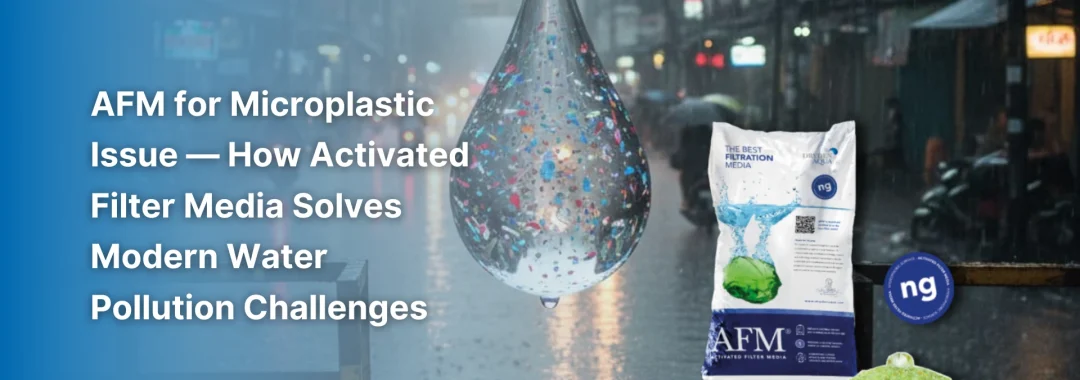AFM for Microplastic Issue — How Activated Filter Media Solves Modern Water Pollution Challenges
Microplastic pollution has become one of the most concerning environmental challenges in recent years. These tiny plastic fragments, often smaller than 5 millimeters, are now found in rivers, lakes, groundwater, and even rainwater. To address this problem, many industries and water treatment facilities are turning to AFM for microplastic issue as a high-performance filtration solution.
AFM, or Activated Filter Media, is an engineered glass filtration media designed to outperform traditional sand filters, especially when dealing with extremely fine particles like microplastics.
Why the Microplastic Issue Matters
Microplastics enter the water cycle through:
- Degradation of plastic waste
- Laundry fibers (synthetic textiles)
- Tire wear particles
- Industrial discharge
- Urban runoff
Studies have shown that microplastics are now found even in rainwater and urban air. One widely discussed study from Indonesia highlights microplastics being detected in rainwater samples in Jakarta, raising questions about long-term environmental and health impacts.
(reference source: U.S. EPA discusses microplastic pollution in water systems.)
This situation demands more advanced filtration methods than traditional sedimentation or sand bed media.
What Is AFM and Why It Works for Microplastic Removal?
AFM (Activated Filter Media) is an advanced filtration media made from processed green glass, engineered to deliver:
- Better filtration performance
- Reduced biofouling
- Higher removal of microscopic particles
- Chemical-free operation
Compared to traditional sand, AFM has enhanced surface activation that traps smaller particles more efficiently. It can filter down to 5 microns, making it effective at capturing microfibers and microplastic fragments that conventional media would allow to pass through.
You can explore other filtration products such as Liqua-Zen Z468 which are often paired with AFM for optimized system performance.
How AFM Removes Microplastics from Water
1. Enhanced Surface Activation
AFM has a negative surface charge that attracts positively charged microplastic particles, improving adsorption.
2. Superior Filtration Depth
Its uniform particle shape and activated surface create deeper filtration zones, trapping particles as small as 5 microns.
3. Less Biofouling
AFM resists bacterial growth, preventing mudballs and channeling—problems that reduce sand filter performance over time.
4. Self-Sterilizing Properties
AFM contains free radicals that continuously disinfect the media surface, maintaining consistent filtration efficiency.
5. No Chemical Additives Needed
AFM works effectively even without flocculants, though systems using coagulants such as Special Coagulant often achieve even better microplastic removal rates.
Advantages of Using AFM for Microplastic Issue
✔ Removes Microplastics Down to 5 Microns
Ensures cleaner, safer, and more sustainable water.
✔ Long-Term Media Stability
AFM does not degrade like sand and can last indefinitely when properly backwashed.
✔ Reduces Chlorine Demand
Due to its bio-resistant surface, AFM minimizes organic contamination.
✔ Improves Water Clarity
Ideal for drinking water treatment, industrial wastewater, resort filtration, and municipal utilities.
✔ Environmentally Friendly
Made from recycled glass and requires no chemical treatment.
Applications of AFM in Indonesia
Industries across Indonesia are now transitioning to AFM in the following areas:
- Drinking water treatment plants
- Resort filtration systems
- Industrial wastewater treatment
- Hotel water filtration
- Swimming pool systems
- Municipal water utilities
For advanced process stages such as polishing or membrane systems, AFM helps protect downstream technologies like RO units. Learn more in Reverse Osmosis Cleaning Agent.
External Sources for Microplastic & Filtration Research (Linked to Keywords)
Leading organizations have published studies confirming the severity of microplastic pollution:
- UNEP microplastic pollution overview
- ScienceDirect research on microplastic treatment technologies
- WaterWorld report on filtration and microplastics
These sources highlight the need for advanced filtration methods such as AFM.
Conclusion: AFM for Microplastic Issue Is the Modern Solution
The increasing presence of microplastics in Indonesia’s water supply demands innovative and reliable filtration solutions. AFM for microplastic issue is a proven and sustainable technology that surpasses conventional sand filters in removing microscopic contaminants.
With support from PT. Gapura Liqua Solutions (GLS), industries and utilities can implement AFM solutions that ensure cleaner, safer, and microplastic-free water.
